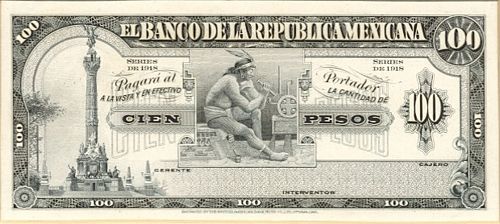El Banco de la República Mexicana
by Cedrian López-Bosch
After the Mexican Constitution was approved in 1917, Venustiano Carranza submitted a bill to create a single bank of issue. Some proofs and specimens of its notes are known to the numismatic public, but not so their story. After spending several months researching different sources, normally not reviewed by the numismatic literature, I present here an attempt to explain how these specimens came into existence and why this project was never realized.
Given the voluntarily or non-voluntarily support provided by the banks of issue to the government of Victoriano Huerta, on 24 September 1913, in the speech in which he set the reform agenda of the movement, Venustiano Carranza, First Chief of the Constitutionalist Army said:
We will change all the current banking system, avoiding the immoral monopoly of private companies that for hundreds of years have absorbed the public and private wealth of Mexico. Actually, we already have circumvented the issue, rather the right to issue paper money by private banks, which should be the exclusive privilege of the Nation. When the Revolution succeeds, a Single Bank will be established, the State Bank, should it be possible, removing any banking institution not controlled by the government“Un discurso trascendental del Señor Carranza, en el Ayuntamiento de Hermosillo Sonora” in Senado de la República, Documentos Históricos Constitucionales de las Fuerzas Armadas, México, 1966 (http://biblio.juridicas.unam.mx/libros/6/2883/14.pdf) A slightly different version of this passage was quoted by Antonio Manero in La Reforma Bancaria en la Revolución Constitucionalista, Talleres Gráficos de la Nación, Mexico City, 1958, p. 67..
Three years later, Rafael Nieto, Deputy Secretary of Finance, appeared before the Constituent Congress to propose to include the issue of banknotes among the activities excepted in the text of Article 28, on monopolies. Along with the mint, post, telegraph and radiotelegraphy services, issuing banknotes would not be a monopoly but would be in the charge of a single bank controlled by the federal government. While the deputies’ discussion diverted into the way in which the government would participate in this single bank of issue, this matter was left to be discussed at a later ordinary Congress and approved as a separate law.
Most of us have read or heard that this is the direct precursor of the Bank of Mexico and that it took eight years to materialize, while the resources were secured; internal political consensus was achieved; its nature was defined and the role of government was agreed upon. However, in the meantime other projects to regulate this revolutionary aspiration were presentedBefore the Constituent Congress there was a project to establish the Banco del Estado Mexicano and in the so called Convention of Aguascalientes another one to create a Banco de México, with two thirds of private capital and one third of capital from the government. After the Constitution was approved, Carranza’s government, Deputy Antonio Manero and the Finance Minister of the Interim President de la Huerta submitted their own proposals to create the Banco de la República Mexicana.. The authors of one of them, the Banco de la República Mexicana, were so convinced of its success that after briefly considering the possibility of printing its banknotes in Mexico, they decided to request Canadian and US manufacturers to prepare proofs and decided to print the notes in the latter country.
The Numismatic Collection of the Banco de Méxicohttps://www.banxico.org.mx/ColeccionNumismatica/ has a set of proofs and a set of specimens of the Banco de la República Mexicana. The first (items numbered 6680 to 6689). printed by the Ottawa-based British American Bank Note Co. (BABNC), consists of separate obverses and reverses of 5, 10, 20, 50 and 100 pesos with a combination of classical and indigenous motifs. They bear no signatures, numbering, or dates (they only state 1918 series); some have the imprint of the BABNC and some not. The obverse is printed in black and the reverse in blue.
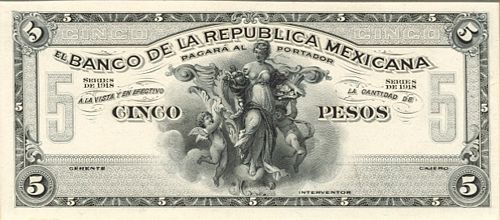
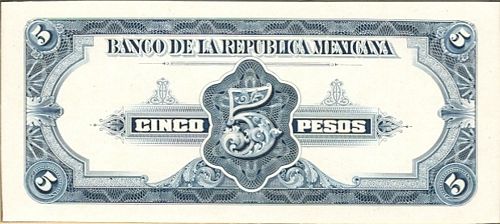
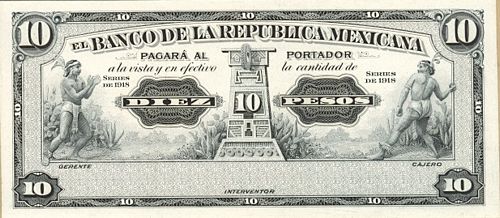
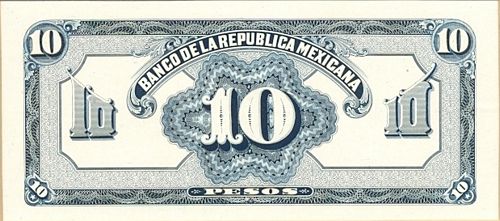
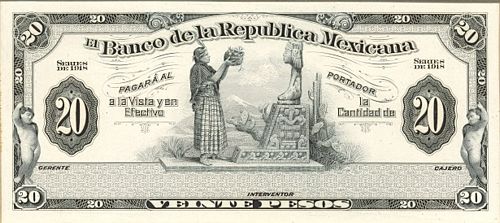
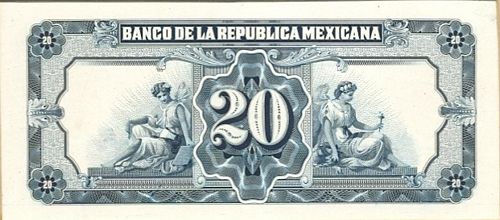
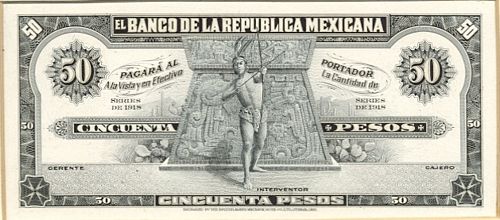
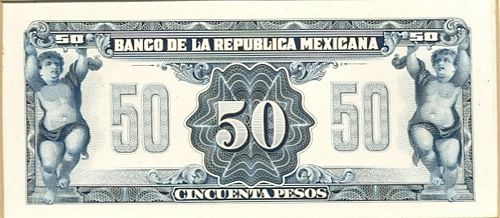
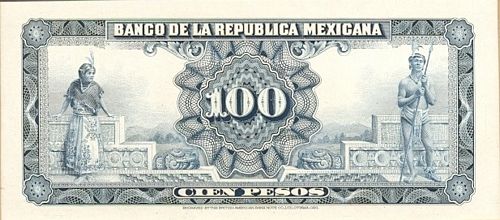
The specimens (items numbered 88 to 92), printed by the American Bank Note Company (“ABNC”) of New York, consist of a set of the same denominations printed on both sides. The obverses are printed in black with a different allegory on each oneUpon the sale of the ABNC files, it is much more common to see this type of vignette on the numismatic market; those produced specifically for a client normally bear the name of this company/issuing authority and the prefix “Special”. The rest were part of the ABNC catalogue and were offered to different clients, which explains why they appear in different banknotes, stocks certificates and securities. These latter only bear a number (preceded by a letter) and sometimes the name of the vignette. For a full description on this taxonomy of the dies and vignettes as well as the relationship with the evolution of the ABNC vide Mark Tomasko’s article “Die Numbers Reflected Changes at ABN” in Bank Note Reporter 32.6, Jun 2004.. These vignettes came from the ABNC archives, i.e. they were not made specially for these banknotes nor for the Banco de la República Mexicana, but were widely used in banknotes, securities and stock certificates for other clients of this security printer.
An image of Kalliope, the Greek muse of epic poetry, engraved by William Adolph in 1916, classified as C-1507 by the ABNC is shown on the obverse of the five pesos note. It was also used on the 1922 Bank of Greece’s 25 drachmas note (P-65) and on a family of notes of the Banco Occidental de El Salvador from 1929 (PS-191 to 199), as well as about 50 stock certificates.
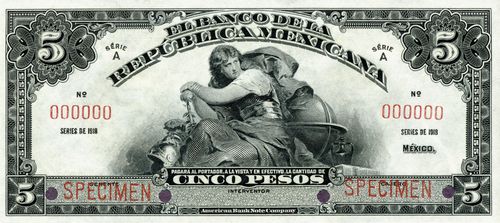
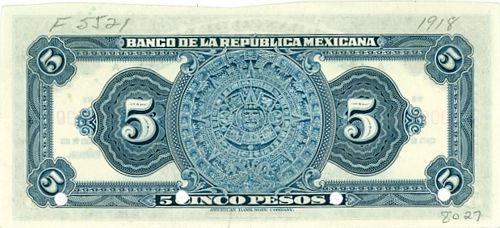
The ten pesos note bears the image of a reclined woman next to a seated lion. This is the vignette C-1155 engraved by Charles Skinner in 1909. It was also used in more than twenty securities (stocks and bonds) in the US and Canada.
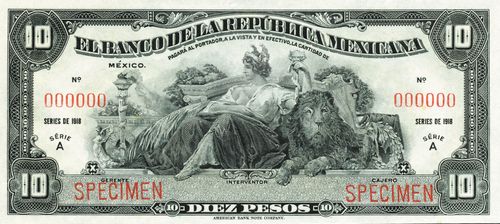
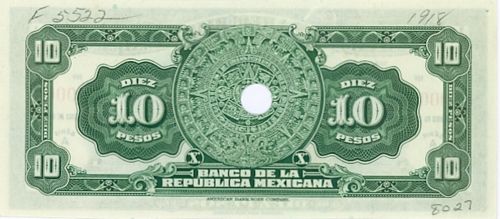
Charles Skinner is also the author of vignette C-1508, engraved in 1916 from a painting by A. E. Foringer. It bears two female figures, one standing with a model of a plane from the time and another one seated. This vignette was not only used to illustrate the twenty pesos banknote of the Banco de la República Mexicana, but also the 1924 two pesos note of the Caja de Conversión del Banco Internacional de Costa Rica (P-184), over-stamped in 1939-40 by the Banco Nacional (P-197), as well as in the unissued 1918 50 ruble credit note from Russia (P-39B) and in several securities.
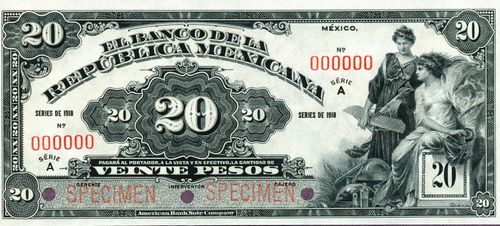
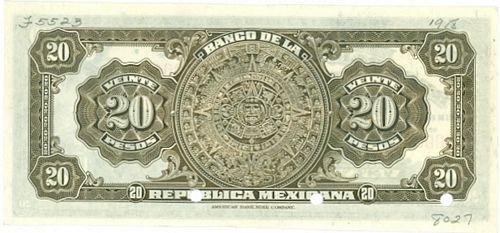
The fifty pesos banknote is illustrated by two seated figures; a male figure on the left holding a scythe and a sheaf of wheat (C-1003) and a female figure on the right holding a ship (C-1002). Both of them were engraved by Charles Skinner in 1905. This composition was also used between 1916 and 1934 on the 10 bolivares notes from a private bank in Venezuela, the Banco de Maracaibo (PS-216, 223 and 226).
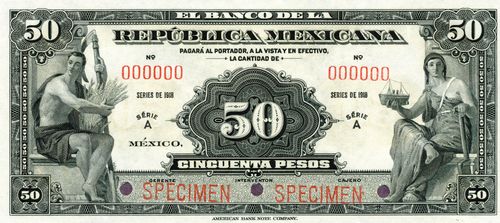
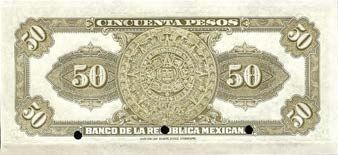
Finally, the vignette of the 100 pesos (C-846) was engraved in 1901 by one of the most prominent artists at ABNC, Robert Savage, and was also used on banknotes in Brazil, Canada, the Dominican Republic and the 1,000 pesos note from the Banco de Tamaulipas, as well as in some securities. Altered versions of this same vignette were also used by the ABNC.
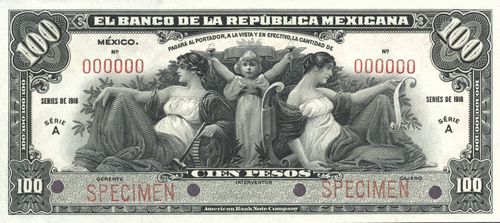
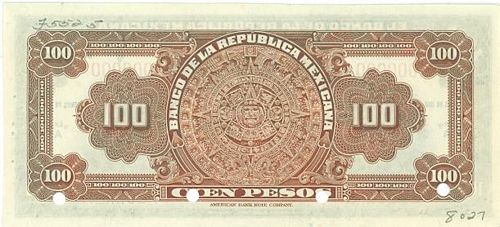
The reverse is printed in different colors in each denomination, in blue, green, sepia, green olive and carmine, respectively. All of them have guilloches and the famous Aztec Calendar (Special C-759 for the Banco Occidental de México). This illustration was etched by Edwin Gunn and Charles Skinner in 1900, and used on the 500 pesos note for the bank it was prepared for and the renown one peso note from the Banco de México between 1935 and 1970, and proposed for some other notes during the Mexican revolution.
These specimens bear series A, but do not have any signature or date; folio numbers are zero and all have the imprint on both sides. After the ABNC archives were sold, several sets of these specimens reached the numismatic market and, more recently, some photographic prints of the preliminary and final models, also known as bromides, were auctioned by Lyn Knight (lots 3959 to 3969, Auction June 2016). These photos are most likely the models rejected and modified, as they show minor differences in the titles, signature titles, dates and fonts and completely different backs. The bromides include the following backs:
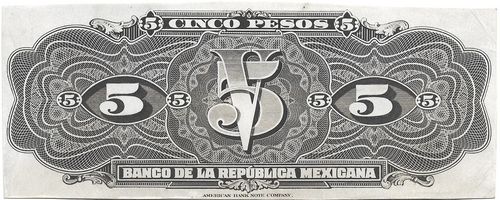
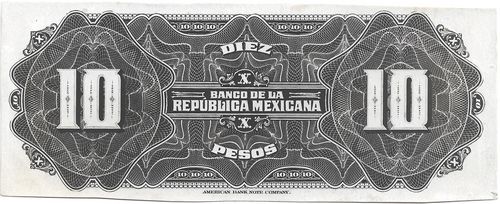
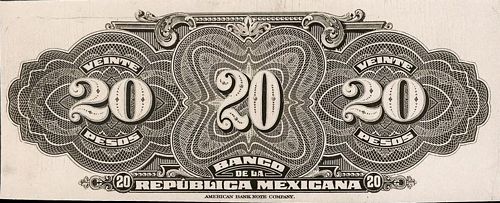
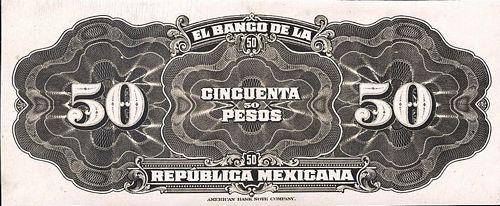
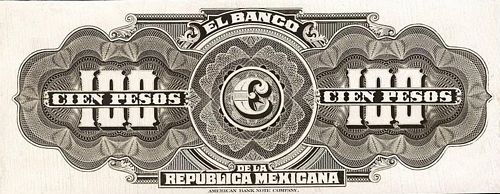
though in the the end a reverse featuring the Aztec Calendar was chosen.
Let us see what was the idea behind this bank and how these numismatic items appeared. If the economic reorganization, the restructuring of the monetary situation and the reestablishment of credit were priorities for Venustiano Carranza as First Chief of the Constitutionalist Army, they were even more relevant for him as President. Therefore, and in order to fulfill the constitutional mandate to create a single bank of issue, in July 1917 he requested permission from the Congress to undertake a loan -never exercised-, and in December of that year, seven months after his inauguration, through the Undersecretary of Finance Rafael Nieto, he presented a draft bill to the XXVII Congress to create the Banco de la República MexicanaManero, op.cit. pp. 386-396..
According to Antonio Manero, this proposal had its origin in two separate committees: The first one, composed by Fernando González Roa, Elias S. A. de Lima, David Murhead, José J. Reynoso and Eduardo del Raso, suggested the creation of a bank with private equity and management. The second one, consisting of Alberto J. Pani, Manuel Aguirre Berlanga and Manero himself, as per President Carranza’s instructions, amended the former to present it as a national bank to the CongressManero, op.cit. pp. 147-148. Some of these names will be relevant a few years later for the establishment and supervision of the Banco de Mexico.
According to this initiative, which presupposed the normalization of the government’s finances, it was possible to lay a solid foundation for reviving the country's economic life by creating a bank with a paid up capital of two hundred million pesos provided (and administered) by the state. This institution would take deposits, discounts bills and issue banknotes up to double of the paid-up capital as well as perform Treasury functions. Its banknotes, as described by Article 5, "[could] not be worth less than five pesos and would be redeemable in cash, at full value, at sight and to the bearer on demand at the head offices"Manero, op.cit. p. 392. As in the Constituent Congress, press and lawmakers’ discussions centred upon the origin of the resources and role of government in the administration.
The project was finally reviewed by the committees of Finance and Public Credit, and amended to include private capital and participation in the administration. Nevertheless, "considering that its terms did not meet the real needs of the time"Dictamen de las Comisiones de Hacienda y Crédito Público sobre la iniciativa del Banco de la República, presentada al Congreso por el C. diputado Antonio Manero. México, diciembre, 1920. (http://cronica.diputados.gob.mx/DDebates/29/1er/Ord/19201228.html) it was abandoned by the government in September 1919. The priorities of Carranza’s administration focused on the economic contraction that resulted from the Revolution and the cash shortage. Given the discredit of paper money, he sought to reintroduce metallic coins, minted with the reserves seized from the private banks. However, the increase in the international price of silver forced the government to take new measures, such as reinstating the gold standard and reducing the silver content in coins to 0.800 in November 1918 and to 0.720 in October 1919. While Carranza’s intention was to replace the first project of the Banco de la República Mexicana with another one according to the new reality, he had no time to present it before his assassination.
However, the withdrawal of this project did not mean the disappearance of the idea of creating the bank. Deputy Antonio Manero, who had participated in the Regulatory Commission, in the first project submitted by Carranza, and analyzed in depth the banking problems of the country, developed another bill for the bank in the context of a reform of the General Law of Credit Institutions. The bylaws he suggestedManero, op.cit. pp. 410-425, and Dictamen, pp. 425-432. envisaged the creation of a privileged deposit, discount and issuing bank, still under the name of the Banco de la República Mexicana, with a capital of one hundred million gold pesos, half in shares (type A), underwritten by the state, and the other half in type B shares, underwritten by commercial banks and private individuals, both domestic and foreign.
The functions of the bank proposed by Manero would include issuing bank notes. These could be worth 5, 10, 20, 50, 100, 500, and 1,000 pesos in national gold; and would state in Spanish the obligation to pay in cash, at face value, at par and on demand in the offices of the bank; and bear issue date, serial number and signatures of the President of the Bank, Cashier and the Comptroller General of the NationThe 1917 Constitution also launched a reorganization of the administration which included the creation of the Department of the Comptroller and the issue of a related law to “ensure the efficiency, economy and morality of the public administration”., at least one of them autographed. These banknotes would be legal tender throughout the country, and would be exchanged for coinage, at par, at sight and to the bearer at the headquarters of the Bank, while branches and agencies would be required only to redeem the banknotes that they had issued, which would bear their own seal. While the Congress hoped to discuss this proposal alongside the revised version from the Federal Government, the early termination of the latter compelled the committees of Finance and Public Credit of the XXIX Congress to make a determination with minimal changes in December 1920.
Additionally, the Partido Liberal Democrático considered the establishment of this bank among its general principlesvide https://www.memoriapoliticademexico.org/Textos/6Revolucion/1919-M-JCO-PLM.html. General Salvador Alvarado, one of the leaders of that party, as Secretary of the Treasury of the Interim President Adolfo de la Huerta, in collaboration with his Deputy Secretary Manuel Padrés and Pedro Solis Camara, Fernando González Roa and Alfonso Caso, elaborated a project on banking organization in the country that included, among other provisions, a General Law of Credit Institutions with a chapter devoted to the establishment and organization of the Banco de la República MexicanaAlvarado et. al. (1920). According to this proposal, the bank would assume a form of joint stock company, with no less than ten million pesos capital, at least half of which it would be underwritten by the Federal Government and the rest by the general public. Regarding its banknotes, the project suggested they should be payable at sight, to the bearer, in cash; they would be of voluntary acceptance except for the federal offices, which were obliged to receive them in the payment of taxes, and should not exceed three times the paid-up capital. Further details on the requirements for issue, values and other data they should bear would be defined in specific regulations and the bylaws would also define the procedures to identify, record, stamp and check that the banknotes met all the requirements set out by the law. To my knowledge, these regulations and bylaws were not elaborated. This proposal reached the Congress, but was not discussed individually. It was rather considered together with other initiatives.
It is clear that by then most of the political actors agreed on the urgency to regularize the situation and issue paper money. President Alvaro Obregón, who took office on 1 December 1920, considering that there were no conditions to fulfill the constitutional mandate, on 5 February 1921 submitted to the Chamber of Deputies a bill to amend Art. 28 of the Constitution authorizing up to eight issuing banks with capital of at least ten million pesos each, while conditions improved, credit strengthened and the trustworthiness of the government increased. These banks could issue banknotes of five pesos or more, of voluntary acceptance. However, lawmakers did not welcome this initiative and Obregón withdraw it ten days after submission, and ten days later presented a new project, this time of a single bank of issue, whose name would be the Banco de México. Thereafter, Obregón instructed his government to make efforts in Mexico and abroad to lay the foundations of this institution. From this moment on, any reference to the Banco de la República Mexicana disappears, but several of its principles were later incorporated in the Act that created the Banco de México.
In parallel to these proposals, plans for printing banknotes were being undertaken. The government press announced that the Stamp Printing Office (Oficina Impresora de Estampillas) would print the notes with special equipment purchased in the United States“Los billetes del Banco Único serán hechos en México”, El Pueblo, Año III, Núm. 1018, 25 August 1917. I do not know if any model was produced in Mexico, as the proofs, bromides and specimens suggest that it was decided to print them abroad, or at least, as seen below, the first notes would be printed outside the country and thereafter they were expected to be produced in Mexico.
The bromides of models and specimens by the ABNC and the BABNC proofs seem to correspond to Carranza’s project. In the transitory articles, he noted that the bank would start working on 1 April 1918 and they all have that year on the obverse. Also, they include the signatory title of a Manager, a position that only appears in his proposal (Art. 18), while the one of Deputy Manero says that the banknotes should be signed by the President of the Bank, the Cashier and the Comptroller General's Office and although General Alvarado’s proposal left these details to regulations and bylaws, apparently these were not released.
While only proofs and specimens with no value are known, several references point out that the ABNC ones were printed. Among the documents in the Numismatic Collection of the Banco de México, there is a letter signed by Undersecretary Rafael Nieto to Mexico’s Financial Agent in New York, Alfredo Caturegli, dated 7 February 1918, instructing him to sign the contract with the ABNC for the printing of banknotes and to arrange the technical details with Mr. (Fernando?) Fernández.
The printing of banknotes in the United States was announced more than a month before, on 15 December 1917, by the newspaper El Pueblo, detailing that it would be according to Secretary Cabrera’s instructions, with models brought to New York by Mr. Fernández, Head of Department of Engraving at the Stamp Printing Office, in the following amounts: six million banknotes of five pesos; three million of ten pesos; two million of twenty pesos; 800,000 of fifty pesos; 600,000 of a hundred pesos; 200,000 of five hundred and 100,000 of a thousand pesos“Va a comenzarse la impresión de los billetes del Banco de la República”, El Pueblo, Año III, Núm. 1129, 15 December 1917. Interestingly, these last two denominations were not mentioned in Carranza’s proposal, but in Manero’s. In late January 1918, the El Paso Morning Times confirmed that Mr. Fernández was in New York overseeing the printing of notes of the Banco de la República Mexicana“Noticias de México: Los nuevos billetes”, El Paso Morning News, 27 January 1918, an order which was supposed to be completed by the end of that month or early February. A letter from Mr. Fernandez dated 23 April said it would be completed by the end of that month.
Finally, according to ABNC records compiled by Ricardo Magan, this company in February 1918 printed 2,800,000 banknotes on 24-subject plates per sheet: 1,750,000 of five pesos (series A and B); 700,000 of ten pesos; 200,000 of twenty pesos; 95,000 of fifty pesos and 55,000 of one hundred pesos, all Series ARicardo M.Magan, Latin American Bank Note Records: American Bank Note Company Archives, 2005, p.159. These notes correspond to ABNC orders F5521 to F5525, numbers that can be seen either printed in red ink or annotated in pencil on many of the specimens. In March 1918 the Mexican press was waiting for their arrival in the country“El 22 del corriente llegarán á Mexico los Billetes del Banco Único de la República”, El Informador, Año I, Tomo 11, Núm. 152, 6 March 1918, and at some time they were delivered to Mexico, though they were never put into circulation and must have subsequently been destroyed.
| Date | Value | Series | from | to |
| February 1918 | $5 | A | 1 | 1000000 |
| B | 1 | 750000 | ||
| $10 | A | 1 | 700000 | |
| $20 | A | 1 | 200000 | |
| $50 | A | 1 | 95000 | |
| $100 | A | 1 | 55000 |
Originally, I assumed that after discarding the idea of manufacturing these banknotes in Mexico, the Mexican authorities requested both security printing houses, BABNC and ABNC, to quote and prepare the models, favoring the ABNC in their decision. However, a number of documents found at the Diplomatic Archives of the Ministry of Foreign Affairs has made me rethink this assumption. In an exchange of messages between Mexico’s Ambassador to the United States, Ignacio Bonillas; the editor of the Mexican Review, George F. Weeks; Undersecretary Nieto and Mr. Fernando Fernández, on the publication of images of such notes in the aforementioned magazine, the latter sent to the diplomat photographs of twenty specimens, a complete set of obverse and reverse sides of each of the two companies’ models. When he referred to the ones made by the BABNC, he said "for these subsequent issues, special watermarked paper with the legend 'Banco de la República Mexicana' was requested to the United States Paper Export Association, which has already been completed, and we are only waiting for the Washington government to grant the export license in order to be brought to this capital..."Archivo Histórico Genaro Estrada. Acervo Histórico-Diplomático. Secretaría de Relaciones Exteriores. legajo 593, exp. 3 This means that the intention was to introduce both models, first those printed in the United States by the ABNC and later to print in Mexico those with the plates engraved by the BABNC in the special watermarked paper produced in the US, perhaps gradually to replace those of the ABNC. Of course the banknotes faced the same destiny as the bank, but this would explain why the allegory on the five pesos proof made by BABNC -the Goddess Tike according to the José Antonio BátizJosé Antonio Bátiz, Historia del Papel Moneda en México, Mexico City, 1984, p. 127 - would be used two years later by the Government Printing Office in the one peso note issued by the Comisión Monetaria.
In the Banco de México Numismatic Collection they have the duplicate of the original contract signed on 11 February 1918 between Undersecretary Rafael Nieto and Messrs. Warren L. Green and George H. Danforth, President and Secretary of the American Bank Note Company, respectively. According to the contract, 2,800,000 banknotes were to be printed in five denominations, for a total of $47,238.75 United States Gold, including the engraving of the steel plates for the front and back of the five denominations ($1,100 each) and the printing in special planchette paper of 6½ x 2¾ inches.
| Denomination | Quantity | Price per 1,000 notes (U.S. currency) |
Total amount |
| $5 | 1,750,000 | $13.75 | $24,062.50 |
| $10 | 700,000 | $14.30 | $10,010.00 |
| $20 | 200,000 | $19.25 | $3,850.00 |
| $50 | 95,000 | $24.25 | $2,303.75 |
| $100 | 55,000 | $27.50 | $1,512.50 |
| Total | 2,800,000 | $41,738.75 |
The plates and dies were to be deposited in the vaults of the ABNC and remain in its custody subject to future orders.
On 27 March 1925 Charles Blackmore, the ABNC’s Resident Agent in Mexico City, reported that in a conversation with Alberto Mascareñas, the manager of the Comisión Monetaria, the latter had told him that he did not have any specimens of the notes prepared for the Banco de la República Mexicana, and so Blackmore suggested presenting him with a book of specimens. New York was unsympathetic. “The notes themselves, as you will recall, were prepared surrounded with considerable secrecy and, from all we know of this issue, it has been concealed not only from the general public but many, if not all, of the present officials of the government.
Under the circumstances do you think it would be well to give out proofs without governmental authority?
We fully appreciate your thoughts in the matter and there is no question but what it would be a nice attention on our part to Sr. Mascareñas and although we should like to do this we greatly fear it might be the cause of unfavourable comment, - to say nothing of the fact that we would be breaking our invariable rule by giving out proofs without proper authority.
The writer personally handled this order with the government representative at the time it was placed, and he knows – from what was said, that it was not their intention to have this order become known. However, if the writer’s impression about the secrecy of this issue is wrong, it would seem that it would not be a difficult matter for you to obtain for us permission from the proper authorities, and we would be more than pleased to furnish a book in accordance with your idea.
Please understand that we do not mean to be obstinate in this matter, nor do we want to seem to be unwilling to do anything we can to help you to stand in right with the government officials but, under the circumstances, we can not help but feel that nothing but harm would result in complying with your request.”
Blackmore replied “I quite understand the position you are obliged to take in this matter, and before doing anything else I will consult with the proper authorities regarding their wishes in this connection.
For your information I might say that the press has, on various occasions in the past, printed the news that the Bank Notes have been printed and delivered for the Banco de la Republica Mexicana. There is now, therefore, no secrecy about these notes. Nevertheless I know that you would not wish to supply specimens of them without the proper authority to do so.”ABNC, folder 210, Banco de la República Mexicana (1925-1931).
In 1931 when the ABNC was contemplating destroying the plates of the old banks of issue, B. Moreno wrote, on 9 July, “I note that it is your idea not to destroy at this time the plates for the Banco de Mexico, or Banco Nacional de Mexico. Would it not be well to do the same with the plates of the Banco de la Republica Mexicana? Last year, as you know, there was the rumour of a possible issue of silver certificates. At that time I told Mr. Mascareñas that if his bank was in urgent need of silver notes, you could possibly use the above plates with slight alterations to save time” and the ABNC replied on 17 July “Your suggestion that we do not destroy the engravings of the Banco de la Republica Mexicana meets with our approval and we will hold these on hand”ibid..
(based on "Proofs and Specimens of El Banco de la República Mexicana: a failed attempt to create the Single Bank Of Issue after the 1917 Constitution" by Cedrian López-Bosch, USMexNA journal December 2016)

